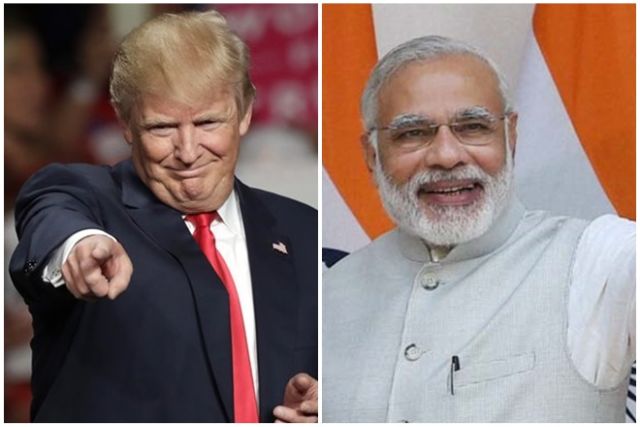
by admin | May 25, 2021 | Opinions
As the economy slows, a pact will send the right message to investors, and change the narrative about India
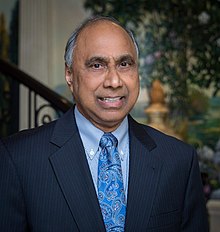
Frank F. Islam
During Prime Minister Narendra Modi’s visit to the United States (US) in September, in which President Donald Trump made a cameo appearance at the “Howdy Modi” event in Houston, the two leaders were expected to announce a trade deal. But, the two sides could not agree on the contours of such a deal before that landmark trip ended.
Media accounts suggested that, over subsequent weeks, New Delhi and Washington appeared to be near a trade deal several times. Nonetheless, as 2019 draws to a close, India and the US are still without a deal.
Two recent bilateral visits give hope, however, that the two countries might reach an agreement soon. In mid-November, India’s commerce and industries minister Piyush Goyal visited Washington to hold discussions with the US Trade Representative (USTR), Robert Lighthizer. And, subsequently, a USTR delegation was in India to continue the talks. Reports say that the two sides are nearing a breakthrough. At a time of general economic slowdown, a trade deal with the US in the waning days of the year would end the economic news for India on a high note.
It is worth noting that since India opened up its economy, the US-India bilateral trade has grown at a spectacular rate. The trade in goods increased from $5 billion in 1991 to nearly $88 billion last year. In 2018, India was America’s ninth largest goods export market. When trade in services is also included to the mix, the volume of bilateral trade last year was $142 billion.
This huge increase in the trade volume does not mean that the two countries were or are on the same page on every trade issue. The US continues to voice its long-standing concerns in primarily two areas: Lack of adequate market access and protection of US intellectual property rights in India. Over the years, India has listened to these concerns and has made concessions. The result is there for all to see: Last year, American companies exported goods exports worth $33.5 billion and services to the tune $25.2 billion to India.
The concerns about market access and intellectual property rights have never become wedge issues in the US, except during presidential election cycles. For example, President George W Bush imposed tariffs on Indian steel to woo voters in the critical battleground state of Ohio, ahead of his 2004 campaign. Not to be outdone, his challenger Senator John F Kerry vigorously went after the Indian outsourcing industry.
President Donald Trump has stated that he believes trade wars are good for the US economy. While trade disputes with Canada, Mexico and China have attracted most of the headlines, Trump has opened new battlefronts with a number of countries, including India.
In May, his administration escalated the disputes with India, when it ended Indian participation in the Generalized System of Preferences (GSP), which had allowed India to export a number of goods to the US at low tariffs for decades. In retaliation, India increased tariffs on 28 US goods.
In the latest rounds of talks, the two countries have reportedly agreed on tariff concessions on dozens of fruits and nuts products, and are close to a deal on medical devices. The major remaining challenge seems to be finding common ground on agricultural products.
This is because Trump is very sensitive about the loss suffered by famers in the US midwest, after China imposed huge tariffs on American agribusiness products as a retaliatory measure. With the midwest farmers critical to Trump’s re-election prospects, the White House has spent tens of billions of dollars in subsidy to those farmers to offset their losses. Getting concessions on agricultural products in a deal with India would resonate with this targeted constituency.
From the Indian side of the ledger, it is likely a good idea for India to yield an inch, a foot , and possibly even a yard , in the ongoing trade talks. New Delhi has more to gain than to lose .
First, it will help change the narrative about the economy. Most rating agencies have downgraded their growth projections for India for next year. A trade deal would reassure US and other foreign investors about India’s future economic prospects.
Second, the US-China trade war has forced many American companies to explore alternative options for manufacturing. For India to take advantage of this vacuum, it has to establish a more predictable trade environment.
Finally, a trade deal has become even more important after India’s decision to stay out of the Regional Comprehensive Economic Partnership (RCEP). The size of the economies of RCEP partners, in the aggregate, rivals the combined economies of the US and Europe.
It is in India’s interest to conclude the ongoing trade talks with the US productively. That does not mean giving away the store, but it does mean being flexible and keeping the larger economic story in mind.
As the axiom goes — and contrary to what the US President believes or says — there are no winners in a trade war. Similarly, a sound trade agreement has no losers.
Frank F Islam is an entrepreneur, civic leader, and thought leader based in Washington, DC. The views are expressed here are personal
Courtesy: This article first appeared in the Hindustan Times

by admin | May 25, 2021 | Opinions
 Respected Prime Minister Sri Narendra Modi Ji,
Respected Prime Minister Sri Narendra Modi Ji,
Pranaam & Happy Ramzaan !
You would kindly recall my PowerPoint presentation made in Gandhinagar, Ahmedabad before you in the conclave ‘Ek Bharat, Shreshtha Bharat’ on June 29, 2013. I followed this up through a couple of my letters to you. I’m grateful to you for having incorporated some of my suggestions in your Party’s and Government’s policies like uploading Muslim friendly articles on BJP’s website and official emphasis on Skill Development and creating its social recognition. Thanks.
- We, in the Muslim community, also appreciate your philanthropic concern regarding general backwardness of Indian Muslims expressed through your maiden 2014 speech in Lok Sabha, later that year your positive vibes about Indian Muslims shared with Fareed Zakaria of CNN and recently your speech in February 2018 at Vigyan Bhawan in the presence of the Jordanian King.
- However, in our country, there continues to be an impression that in recent years there has been an atmosphere where Muslim baiting is becoming a part of the wider social ethos. At various levels – party & government functionaries, sangh parivar, individual activists – some statement or the other or a gesture is made that conspicuously harms the Muslim interests. For one such severe dereliction you had to consequently drop one of your ministers in 2016 for which the community is grateful to you.
- Nonetheless, your Government’s change of stand before the Supreme Court opposing the continuance of minority status of Aligarh Muslim University and Jamia Millia Islamia defies logic. There is no provision in the Constitution or in any other law that if minorities establish an educational institution and later if some executive or legislative action is taken for its recognition, that would vitiate its minority character.
- You know, Sir, that Waqf is a Muslim religious matter. But in the Standing Committee on Waqf Properties (Eviction of Unauthorized Occupants) Bill 2014, appointed after your Government assumed power, out of 29 Members only two are Muslim. The Committee overruled the very logical submissions made by the Ministry’s officers without assigning any reasons and thus took patently anti-Waqf view.
- In your UP election speech of February 2017 your sentence pitching Shamshan against Qabristan warranted greater factual understanding in advance. Hundreds of Qabristan properties of Waqf are being encroached by unauthorized occupants and there is need to get them vacated and to protect them. No such issue has emerged in respect of a Shamshan.
- Your concern against triple talaq is well founded but, statistically, the proposed remedial statute would help a very small number of individuals. On the other hand, if you create Indian Waqf Service (recommended by Sachar Committee but rejected by UPA Government – pointed out to you by me on 29 May 2013) that would go to protect Waqf properties and better manage the Waqf administration earning you tremendous Muslim goodwill.
- Niti Ayog has recently come up with the list of most backward districts in which Muslim predominant districts much outnumber others and obnoxiously find place among the first many spots. This is a result of decades of neglect by the governments of the day. During your regime the Muslim community would be happy to see the tide turning through restoration of their constitutional rights to them.
- Jihad means striving at inner moral uplift by the individual so that s/he becomes more positively useful to the society; it is a sacred article of Muslim faith. But in India, of late, there is a tendency to associate negativity with Jihad linking to it politically motivated prefixes. Some individuals are doing this mischief (even in respect of the community’s internal affirmative actions for self uplift) giving an impression that they have blessings of your Party and Government. This impression needs to be neutralized.
- The apparent dichotomy of your Government’s approach towards the incoming migrants and refugees based on their faith appears at variance with the treasured Indian directive principle ‘Ekam sat viprah bahuda’ as also the spirit of the New York Declaration on Migrants & Refugees, 2016 where your MoS External Affairs was present during drafting and release.
- Respected Sir, the Muslim community is not beholden to any political grouping. It would be happy to incline toward the one who restores to their their constitutional rights and thus uplifts their low social, educational and economic status.
- In this context you would be happy to know that we at Zakat Foundation of India have been working in tandem with your slogan of Sabka Saath Sabka Vikas through our micro and macro institutional projects of Muslim uplift and empowerment. In order to apprise you in detail about these we would feel privileged to make a presentation before you on a date of your convenience.
Looking forward with warm regards
Yours sincerely,
Dr Syed Zafar Mahmood, President
Zakat Foundation of India
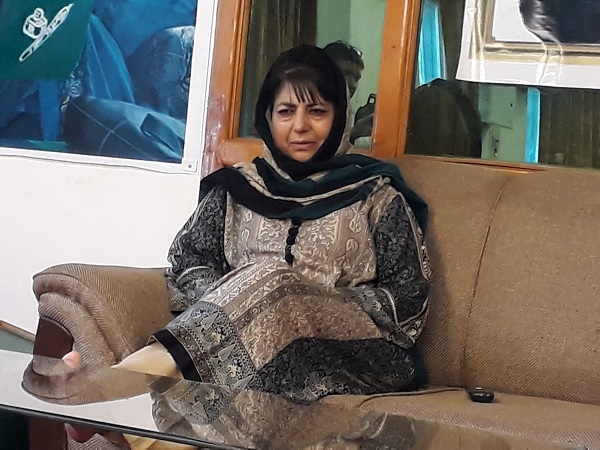
by admin | May 25, 2021 | Interviews

PDP chief and J&K Chief Minister Mehbooba Mufti (Photo:Maeeshat)
By Danish Reyaz for Maeeshat
When the entire Jammu and Kashmir was in grip of Ramadan celebrations, PDP chief and state Chief Minister Mehbooba Mufti was praying for arrival of tourists in the valley. Since there were a lesser number of tourists this year, she was deeply concerned — if tourists didn’t visit the valley during this season, the state economy would be devastated. The famous Dal Lake was at its splendor, still most of the hotels in the neighbourhood were unoccupied. The Shikaras at the lake waited for tourists but there were hardly any people to enjoy the ride. Markets were empty since there were no buyers. At Sonmarg hills, horses were ready for the ride but there was none to put his feet in the saddle. The beautiful valley was gripped by some unknown fears.
It seems that the decision of the state government to invite journalists, writers and travellers from across the country for FAM tour, organised in collaboration with the Department of Tourism J&K, had stemmed out of this anxiety. During the meeting with the delegation at her residence in Srinagar, she kept repeating that J&K is the valley of peace and harmony and people must visit it to free themselves from the fears. She stressed, “Yes, there is fearful atmosphere and tense situation but it is only there on the borders. But this is also a fact that because of these conditions tourists are never troubled. Tourists are honoured and protected everywhere since the issues are between the Government of India and the people of J&K. It will be great if people from different parts of the country visit the valley, enjoy its splendid beauty and take pleasure of the Kashmir delicacies.”
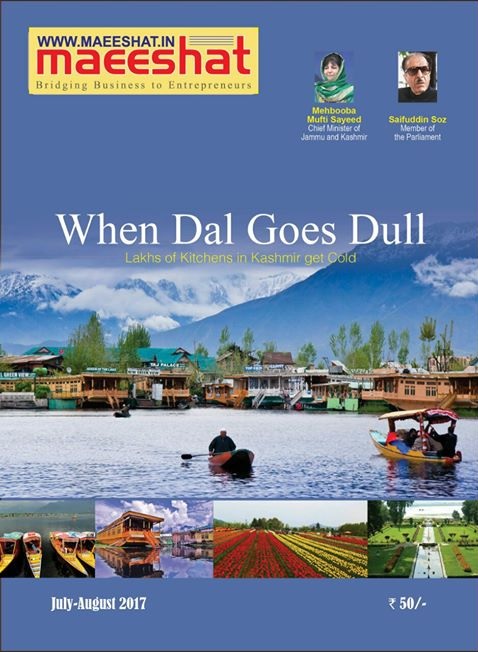
Maeeshat Magazine Cover Page (July-August 2017)
As ours was a multi-faith delegation of journalists and writers, she highlighted the plural culture of society.
“We have Amarnath temple, Akhir Bhawani Mandir, Mata Vaishnodevi Mandir, Shiv Khori, Shankar Acharya Mandir, Martson Mandir etc and it is a fact that Muslims make all the suitable and comfortable arrangements for these pilgrimages. However, such a situation has been created that now people are afraid, so much that they even avoid visiting the valley. On the other hand, you won’t find a single Kashmiri who has not visited the shrine of Nizamuddin Auliya in Delhi and Khwaja Moinuddin Chishti in Ajmer. People go to Ajmer in large number to mark their religious duty but hardly anyone from there comes to visit the shrines of great saints in Kashmir and other religious places like Khanqah-e-Maula Ali, Hazrat Bal Masjid, Charar Shareef etc.,” she said.
Mehbooba left no stone unturned to convince us that it is tourism, nothing else, which will make the bond between Kashmir and the rest of India stronger.
“When tourist visit will increase it will automatically create a better personal cordial relationship with the local people. When trades will begin then mutual understanding and trust will also develop. The illusion will vanish but for that, people from the country must visit the valley.”
Fully aware that our delegation had several journalists, Mehbooba talked about negative presentation of the state in TV news channels of Delhi.
“In various parts of India, women have difficulty in venturing out at night but Kashmir is the only place where they are safest. Here girls can venture out at night without any hesitation and fear. When tourists roam on the streets whole day and then watch TV at night at hotels, they become suspicious about the intension of the media. Because, they cannot believe that the places they visited earlier in the day are having such a horrendous atmosphere as claimed by the media.”
Mehbooba is much miffed with the electronic media. She strongly says that Media has always worked towards tarnishing the image of Kashmir.
“The way minor skirmishes are reported and repeated whole day on TV channels, people are forced to believe that it is a routine in Kashmir. If a young lad pelted stones somewhere then after every news item his video will be played. Although stone pelters are very few in numbers, still a fearful atmosphere is being created by the media. And there is a side effect of such media coverage: As stone pelters are repeatedly shown on television they begin to assume themselves as hero. So, when the boys who are not part of stone pelting see their friends on TV they also feel proud of committing the act,” she said. “I, therefore, feel that the electronic media is badly affecting us in two ways. First, it’s misguiding our youth; and second it’s tarnishing the state’s reputation. The fact is that these mala fide stories aren’t just tarnishing Kashmir’s image they are also affecting the Jammu region, hence even Kashmiri pundits are also getting defamed and are facing the hardship. In other words, I can say that they are trying to create fear and hatred in the minds of the people. In case the situation turned hostile then it might turn out to be worse.”
In the hour-long meeting with delegation, the J&K Chief Minister also spoke about the state’s achievements and wished that they should also be highlighted by the media.
“In this tense atmosphere, our students are successfully passing the civil services exams. A Kashmiri kid is representing India in Commonwealth youth games and playing football for the country in Scotland. We have also begun bus services for women, introduced the Ladli scheme, established women police stations and have also launched Scooty for girls scheme. Millions of students are accomplishing their education but nobody promotes such positive news. Rather, media is keener about negative stories and it telecasts them day and night,” she said.
Before ending her speech, she boldly enticed Prime Minister Narendra Modi to resolve the issue of Kashmir.
“The issue of Kashmir cannot be solved without talks; dialogue is needed to solve this issue. We want a solution only through dialogues. Mufti Mohammed Saeed and Atal Bihari Vajpayee had a better understanding of the case because they both used to listen to each other. I think, now Prime Minister Narendra Modi can only do something better since he has the nerves and potential to bring a solution. If he can’t bring a solution then nobody can! If he solved this issue then I am sure he will get the Nobel Prize for Peace,” said Mehbooba with the hope that her message and strong urge for peaceful resolution of the Kashmir issue would be conveyed to Delhi.
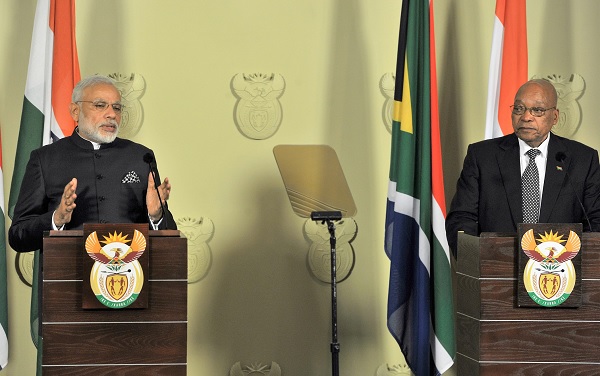
by admin | May 25, 2021 | Business Summit, Events, News

Prime Minister Narendra Modi and the President of the Republic of South Africa, Jacob Zuma, during the Joint Press Statement, at Union Buildings, in Pretoria, South Africa
Pretoria:(IANS) Prime Minister Narendra Modi on Friday laid emphasis on industry-to-industry ties between India and South Africa for greater economic gains while thanking South African President Jacob Zuma for extending support to India’s bid for membership in the Nuclear Suppliers Group.
“I am convinced that industry-to-industry ties not only can bring rich economic gains to our societies, they can give a new shape to our partnership, and drive it to new levels,” Modi said in a joint press statement with Zuma following delegation-level talks between the two sides.
“And, in the process, also help both our nations to play a more robust regional and global role,” he stated.
Modi said that in the last two decades, the relationship between the two countries has been a story of strong advances and concrete achievements.
“Two-way trade has grown by over 300 per cent in the last 10 years. Indian companies hold strong business interests in South Africa,” he said.
The Prime Minister said that one-fourth of India’s investments in Africa were in South Africa.
“And there is potential to expand our business and investment ties further, especially in the areas of mineral and mining, chemicals and pharmaceuticals, high technology manufacturing and information and communication technology,” he said.
Modi said that given the nature of the two countries’ developing economies, both should also focus on improving human capital.
The Prime Minister said the two countries could also partner in the field of defence and security.
“Both, at the level of industry and for our strategic and security needs. In India, this is one of the sectors witnessing a complete transformation,” he said.
Modi said, during Friday’s talks he and Zuma agreed on the need to work more closely on international issues and emerging global challenges.
“I thanked the President for South Africa’s support to India’s membership of the Nuclear Suppliers Group,” he said.
“We know that we can count on the active support of our friends, like South Africa,” he stated, adding that climate change was another issue of shared concern.
He said that both sides agreed to “cooperate actively to combat terrorism, both in our region and in the world”.
He welcomed South Africa’s chairmanship of the Indian Ocean Rim Association and said that it has emerged as a key platform of engagement for the maritime neighbours connected by the Indian Ocean.
On a personal note, Modi said the visit has given him the opportunity to pay homage to the two great souls, Mahatma Gandhi and Nelson Mandela.
In his remarks, President Zuma said that over 100 Indian companies were operating in South Africa and these were playing a “significant role” in the country’s economy and job creation.
“We are looking to diversify South Africa’s exports to India,” he said.
Zuma cited the defence sector, deep mining and renewable energy as areas of bilateral cooperation.
According to him, water management, pharmaceuticals and infrastructure development are areas that hold potential in the future.
The President also called tourism promotion for improving people-to-people ties.
Following Friday’s talks, both sides signed three memorandums of understanding – on information and communication technology, tourism, and grass root innovation in the science and technology – and a programme of cooperation in arts and culture.
After a lunch hosted by Zuma, South African Deputy President Cyril Ramaphosa called on the visiting dignitary.
Modi and Zuma are scheduled to attend an India-South Africa business summit later on Friday.
The Prime Minister will then visit the Constitution Hill and the Nelson Mandela Foundation in Johannesburg.
In the evening, he will address an Indian diaspora rally in Johannesburg before departing for Durban where his engagements are scheduled for Saturday.
Modi arrived in South Africa from Mozambique on Thursday night on the second leg of his four-nation tour of Africa.
This is his first visit to mainland Africa and is also the first prime ministerial visit from India to South Africa since the then Prime Minister Manmohan Singh arrived in 2013 for the G20 summit in Durban.
Apart from Mozambique and South Africa, Modi will also visit Tanzania and Kenya.
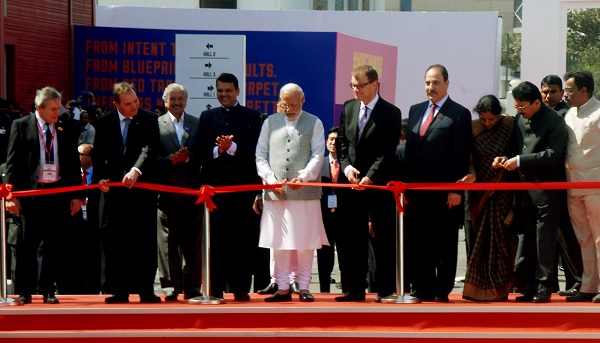
by admin | May 25, 2021 | Economy, Investing, News

The Prime Minister Shri Narendra Modi inaugurate MAKE IN INDIA function at BKC complex in mumbai on February 13, 2016. Chief Minister of Maharashtra Shri Devendra Fanavis and Governor of Maharashtra Shri Vidyasagar Rao, and others dignitary present at inaugural function.(Photo PIB)
Mumbai:(IANS) Unfolding the red carpet for domestic and foreign investors, Prime Minister Narendra Modi opened the “Make in India Week” here on Saturday, showcased as the largest event of its kind in the country to project it as the preferred global hub for manufacturing.
The prime minister also listed a number of initiatives taken by his government to make it easier for doing business in India, along with enabling policy decisions and corrections. “I repeat, we also decided there will be no retrospective taxation,” he said at the inaugural.
“Make in India has become the biggest brand India ever created. It has captured the imagination of people, business, institutions, political leaders and media,” he said at the National Sports Club of India’s indoor stadium that was packed beyond its 5,000 capacity.
Modi said the efforts were showing. “Our foreign direct investment inflow has gone by 48 percent since the day my government came into office,” the prime minister said. He also said concerns over intellectual property and bankruptcy laws were also being addressed.
“Almost on a daily basis we are trying to remove the bottlenecks that were affecting business,” he said. It was, therefore, not surprising that a host of multilateral institutions have said India will log even better growth that the present 7.5 percent in the coming years, he added.
“In 2014-15, India contributed 12.5 percent to global growth. It’s contribution to to the global growth is 68 percent higher than its share of world economy,” he said, amid applause from the audience, which included chief ministers, ambassadors, industrialists and policy-makers.
Modi said India was particularly keen on scaling up investments in infrastructure — from roads and railways to digital networks and clean energy. Towards this, he said, interest-free bonds were the next on the agenda.
“Do not wait. Do not relax. You should take advantage of the immense opportunities in India.”
The event also saw the Time India award conferred on Tata Steel for best in class manufacturing, Hero MotoCorp for innovator of the year and Yogesh and Rajesh Agarwal of Ajanta Pharma for young maker of the year.
Earlier, Commerce Minister Nirmala Sitharaman said India was ready as a global manufacturing hub.
“The idea of the Make in India plan was to make the environment in the country from the regulated to a facilitator,” said Sitharaman, adding this has resulted in a vast improvement in ease of doing business in the country. “This is a moment India is cherishing.”
In his maiden Independence Day address on August 15, 2014, the prime minister had said India must become a global manufacturing hub, with “zero defect” in product quality and “zero affect” in its impact on environment. The “Make in India” campaign was launched a month later on September 25.
Earlier, Modi inaugurated the Make In India Centre at the Mumbai Metropolitan Region Development Authority Grounds with his Swedish and Finnish counterparts, Kjell Stefan Lofven and Juha Petri Sipila, respectively. The two dignitaries also addressed the inaugural event.
Themed on innovation, design and sustainability, the centre showcases some of the country’s most trendsetting products and manufacturing processes before the world for the first time after the global launch of the Make In India initiative 17 months ago, commerce ministry officials said.
Those showcasing their respective strengths include corporate houses like the Tatas and Reliance groups, four top oil companies, as also institutions like the Indian Space Research Organisation and the Defence Research and Development Organisation.
Make in India Centre includes sector-specific pavilions showcasing 11 focus sectors of the six-day event, 17 state exhibitions and several country pavilions. The area covered is some 220,000 square metres and accommodates 27 halls for 190 companies to show their prowess.
Officials said the Make in India Week is an enabling event to showcase India and attract investment, while also providing opportunities to the states. Also planned are some 20 sector-specific seminars in areas like policy, business climate and intellectual property.
The programmes will see the participation of central and state ministers, chief ministers, senior government officials, top industrialists and businesspeople from India and overseas, and several government and business delegations from abroad.
Government delegations from 49 nations and business teams from 68 countries have converged here.







